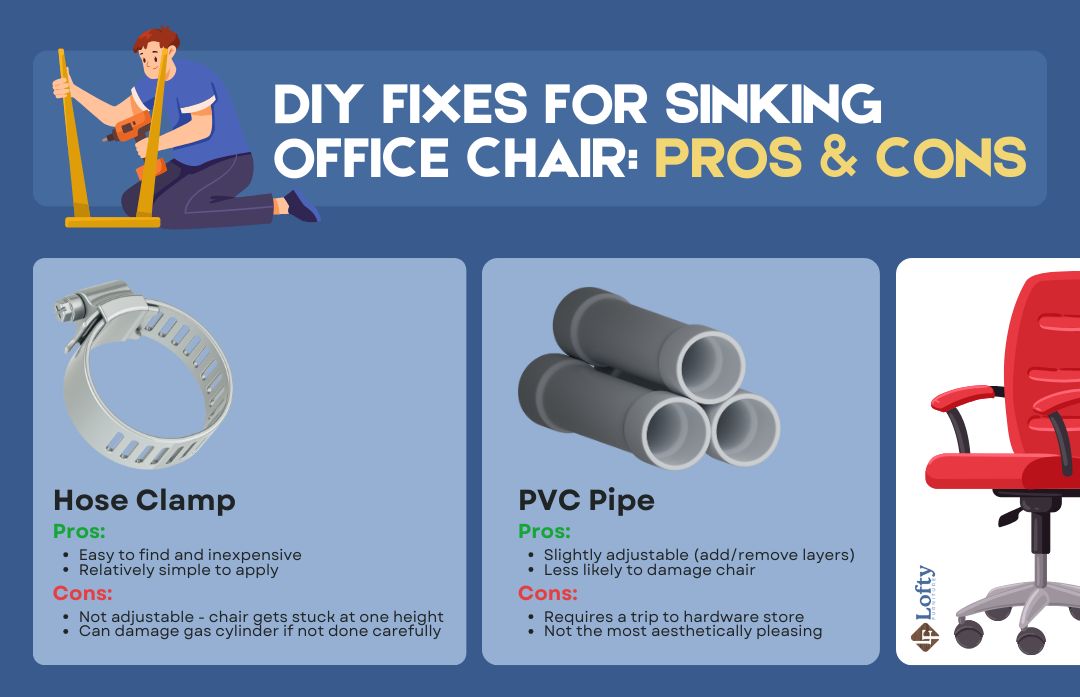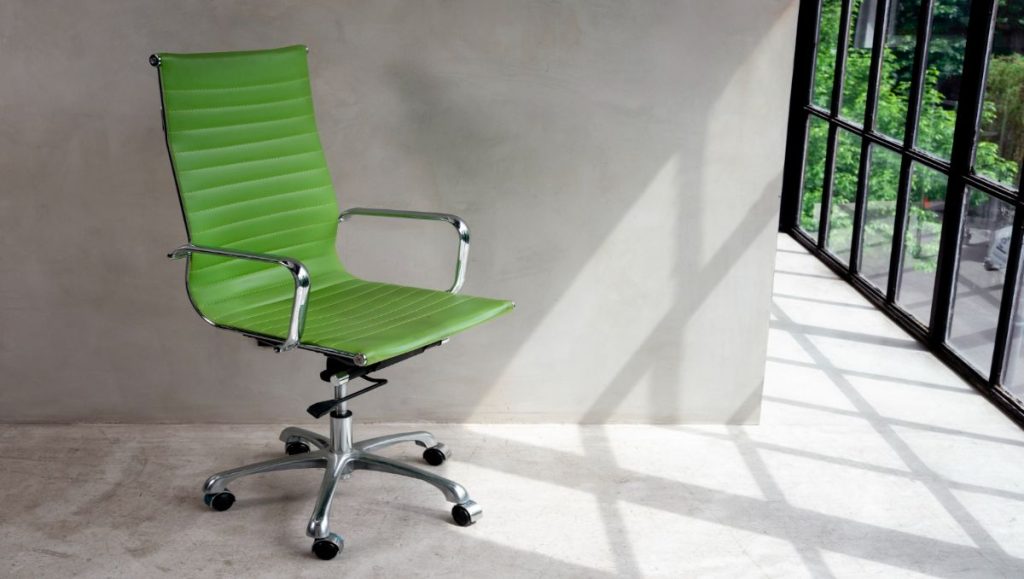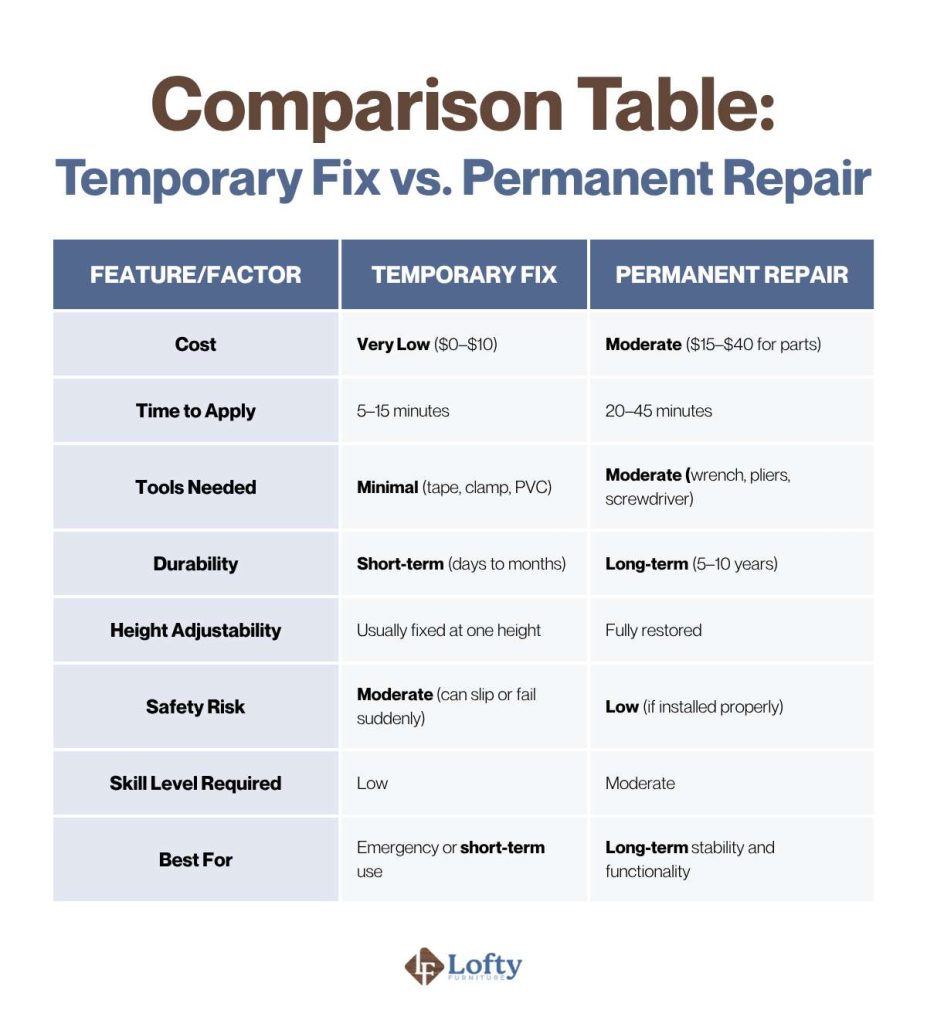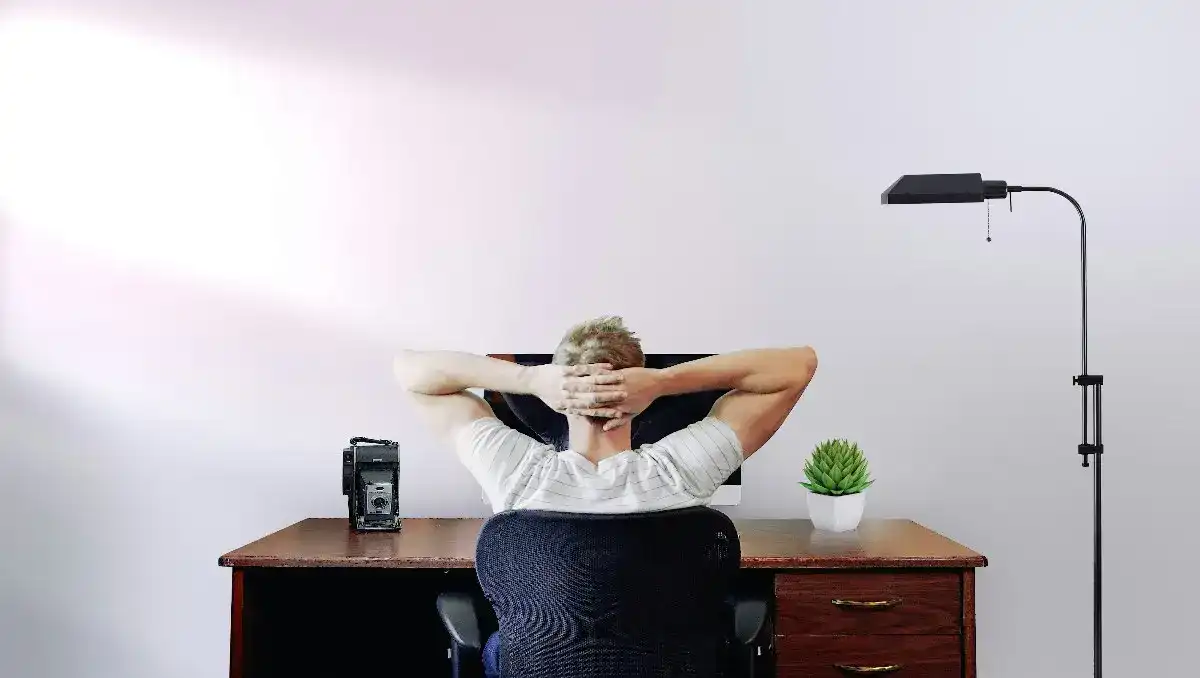Have you ever found yourself comfortably seated at your desk, only to gradually descend until you’re practically at eye level with your keyboard? A sinking office chair can be a frustrating and disruptive issue, interrupting your work and affecting your posture. This common problem can leave you feeling uncomfortable and less productive.
Key Takeaways:
- Your chair keeps going down because the gas lift cylinder is losing pressure. This usually happens when the internal seals wear out over time.
- Temporary solutions like using a hose clamp or a PVC pipe can provide immediate relief and stop your chair from sinking.
- Replacing the gas cylinder is the most effective long-term fix for a sinking office chair, ensuring proper pressure and height adjustment for lasting ergonomic comfort.
- Regular maintenance, such as cleaning moving parts, applying lubricant, and adhering to the chair’s weight limit, can prevent the chair from sinking and extend its lifespan.
This guide explores the common causes of a sinking office chair, along with practical solutions to restore stability and ensure a comfortable working environment.
Why Does My Office Chair Keep Sinking?
If your office chair keeps sinking whenever you sit down, it can be both frustrating and disruptive to your workday. Understanding the common causes behind this issue can help you find a reliable solution and restore your chair’s functionality.

Worn-out Hydraulic Piston
The hydraulic piston, also known as the gas lift or gas cylinder, is a crucial component of your office chair. It allows you to adjust the height of the chair by compressing and decompressing gas. Over time, the piston can wear out due to regular use, leading to a loss of pressure. When this happens, the chair can no longer hold your weight properly, causing it to sink.
Leaking Gas Cylinder
Another common issue is a leaking gas cylinder. The gas cylinder contains pressurized gas that supports the height adjustment mechanism. If there is a leak, the gas will escape slowly, resulting in a gradual loss of height. You might notice your chair sinking a little more each day until it becomes unusable. Leaks can occur due to manufacturing defects or wear and tear over time.
Loose Adjustment Knob
The adjustment knob or lever controls the height of your office chair. If this mechanism becomes loose or damaged, it might not lock the chair at the desired height effectively. A loose knob can cause the chair to sink whenever you sit down, as it fails to maintain the set height. Regularly checking and tightening the adjustment knob can prevent this issue.
Damaged Chair Base
The base of your office chair plays a significant role in its overall stability and height adjustment. If the base is damaged, bent, or cracked, it can affect the chair’s ability to maintain its height. A damaged base can cause the chair to tilt or sink unexpectedly, posing a safety risk. Inspecting the chair base for any signs of damage and replacing it if necessary can help resolve this problem.
So, how do you know which one’s causing the problem for your chair?

Quick Fixes for a Sinking Office Chair
While a permanent fix might be ideal, sometimes you need a quick solution to get you back to a comfortable working height. Here are two DIY methods to temporarily halt your chair’s descent:
Hose Clamp Method
What you’ll need:
- Hose clamp (sized to fit the chair’s gas cylinder)
- Screwdriver (to remove the plastic skirt if necessary)
Instructions:
- Flip the chair upside down.
- If needed, remove the plastic skirt covering the gas cylinder using the screwdriver.
- Locate the desired height for your chair.
- Place the hose clamp around the gas cylinder at that height.
- Tighten the clamp securely, but be cautious not to over-tighten and damage the cylinder.
PVC Pipe Method
What you’ll need:
- Short piece of PVC pipe (with a diameter slightly larger than the gas cylinder)
- Hacksaw (to cut the PVC pipe lengthwise, if needed)
Instructions:
- Cut a section of PVC pipe to a length that corresponds to your desired chair height. You might need to experiment to get the right fit.
- If the pipe is too snug to slide on easily, carefully cut a slit along its length to create a split sleeve.
- Slide the PVC pipe sleeve up the gas cylinder until it reaches your desired height.
Which one should you use to fix your sinking office chair? While both works, they have their own pros and cons:

Long-term Solutions for Sinking Office Chair
When your quick fixes just won’t cut it anymore, replacing the gas cylinder is the most effective long-term solution for a sinking office chair. Before you start with anything, you need to make sure you have the right gas cylinder. First, think about weight capacity and adjustability. Standard cylinders work for most chairs, but for heavier users, a heavy-duty option is better. Measure the stroke length (height adjustment range) of your old cylinder to ensure the new one offers a similar range.
Here’s a video to help you understand how it’s done:
Compatibility is also crucial. Measure the diameter and length of your existing cylinder for a perfect fit. If you can, check your chair’s brand and model for specific gas cylinder recommendations from the manufacturer. Now that you have the right gas cylinder, you need to be familiar with the steps:
Remove the Old Gas Cylinder:
- Disassemble the Chair: Start by turning the chair upside down. Use the pipe wrench to hold the base of the chair steady.
- Remove the Base: Use the wrench to loosen the gas cylinder from the chair base. This may require some force, as the cylinder might be tightly fitted.
- Detach the Cylinder: Once the base is removed, you can pull out the old gas cylinder. If it’s stuck, apply some lubricant and try again.
Install the New Gas Cylinder:
- Insert the New Cylinder: Place the new gas cylinder into the chair’s mechanism. Ensure it’s aligned properly.
- Reattach the Base: Secure the chair base onto the new gas cylinder. Press firmly to ensure it’s fitted snugly.
- Test the Chair: Turn the chair upright and test the height adjustment to ensure the new cylinder is working correctly.
Take note that replacing the gas cylinder might not be the most suitable option for everyone. If your office chair is a high-quality model or has sentimental value, consider seeking professional repair. A skilled furniture technician can assess the problem and determine if replacing the gas cylinder is the best course of action. They may also be able to identify other underlying issues and provide a more comprehensive repair.

Choosing a Quality Replacement Cylinder: What to Look For
Start by checking the height range (commonly 4–10 inches of travel), weight capacity (usually 250–400 lbs), and diameter to ensure it fits your chair base and seat mechanism. Many cylinders are “universal,” but not all chairs follow standard sizing—especially older or imported models. Look for features like ANSI/BIFMA certification (which ensures the part meets durability and safety standards), steel construction, smooth pneumatic action, and multi-year warranties—all of which signal a high-quality product.
Temporary Fixes vs. Permanent Solutions: Which Should You Choose?
When your office chair starts sinking unexpectedly, a temporary fix can feel like a quick win—especially if you’re in the middle of a busy workweek. Methods like using a PVC pipe, hose clamp, or even duct tape can stop the chair from lowering for a while. However, they’re not designed to address the root cause: a failing gas cylinder. Over time, these fixes can wear out, compromise the chair’s adjustability, and even present safety risks.
On the other hand, opting for a permanent solution—like replacing the gas cylinder—may take more time and involve some basic tools, but it restores full functionality and safety to your chair. A new gas lift usually lasts for several years, supports height adjustment, and returns your chair to like-new condition. If you use your chair daily or rely on ergonomic positioning for back health, investing in a proper repair is the smarter long-term choice.

Suffering from a sinking office chair? Upgrade to a modern ergonomic chair today and experience the difference in comfort and support.
How to Stop Your Office Chair from Sinking
Taking proactive steps can help prevent your office chair from sinking and leaning back, extending its lifespan. Here are some practical tips to keep your chair in top condition.
- Every chair has a weight capacity. Always follow the weight limit specified by the chair’s manufacturer. Exceeding this limit can put excessive strain on the gas cylinder and other components, leading to premature wear and tear.
- Avoid jerky movements or rocking in your chair excessively. Sudden, forceful movements can damage the gas cylinder and other parts of the chair. Always adjust the height and recline positions gently.
- Keep the moving parts of your chair free from dust and dirt. Regularly clean the chair’s base, wheels, and hydraulic piston to ensure smooth operation.
- Apply a small amount of lubricant to the moving parts, such as the gas cylinder and adjustment mechanisms, to prevent friction and wear.
You might be interested to learn about ADHD chairs for focus and comfort.
Conclusion
A sinking office chair can be a significant annoyance, disrupting your workflow and impacting your comfort. By understanding the common causes—such as a worn-out hydraulic piston, leaking gas cylinder, loose adjustment knob, or damaged chair base—you can effectively diagnose the issue and take appropriate action.
Whether you opt for a quick DIY fix like a hose clamp or PVC pipe, or invest in a long-term solution by replacing the gas cylinder, addressing this problem will restore stability and enhance your overall work experience. Taking preventative measures, such as adhering to the chair’s weight limit and maintaining its components, will also help extend the lifespan of your office chair, ensuring a supportive and comfortable seating arrangement for years to come.
FAQs
How can I make my office chair more stable?
To make your office chair more stable, regularly inspect and tighten all screws and bolts, ensuring that the base and wheels are secure. Additionally, replacing worn-out components like the gas cylinder or damaged casters can significantly improve the chair’s stability.
Can office chairs be repaired?
Yes, office chairs can often be repaired by addressing issues such as replacing a faulty gas cylinder, tightening loose screws, or fixing a damaged base, which can restore functionality and comfort.
How do I know if I need a new office chair?
You may need a new office chair if it has persistent stability issues, extensive wear and tear, or if repairs no longer restore comfort and functionality, indicating that the chair’s overall structure has deteriorated.
How long do office chair gas cylinders typically last?
The lifespan of an office chair gas cylinder generally ranges from 2 to 5 years, though this can vary based on several factors. Higher-quality cylinders, proper user weight adherence, and moderate usage frequency contribute to a longer life, while exceeding weight limits, constant adjustments, or rough handling can accelerate wear.
Is it safe to use a chair that keeps sinking?
Continuing to use an office chair that constantly sinks is generally not recommended due to potential ergonomic issues and discomfort. A sinking chair prevents proper posture, leading to strain on your back, neck, and shoulders, and can cause reduced circulation and fatigue over time.

Custom solutions delivered, individual attention given. Customization champions found. Customization excellence.